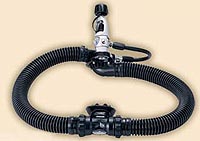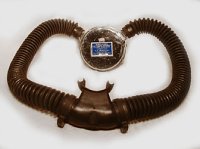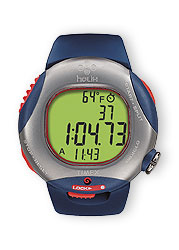« March 2007 | Main | May 2007 »
April 22, 2007
That cool double-hose look
I must admit, I am really intrigued by the cool double-hose regulators seen in Cousteau documentaries and features. So when I came across a "retro" double-hose design, I was very tempted to buy it. I thought about it a lot, discussed it in detail, and then did some research. As usual, there is no definite answer. People like "retro," or else there would be no New Beetle, no resurrected Mini Cooper, no PT Cruiser, no new Ford Mustang, and no plans for reinvented Detroit muscle cars with that vintage look. There is usually a reason why designs change. Time moves on, new technologies replace older ones, and so on. But sometimes we stray too far off course and return to older designs in sort of a back-to-the-future way. Is that the case with the new old double-hose regulator I saw?
 What am I talking about here? That would be a retro regulator made by Aqua-Lung (see picture to the left). "Aqua-lung" was the name of the original diving gear designed by Emile Gagnan and Jacques Cousteau back in 1943. Somehow, today the word, also spelled "Aqualung" and "Aqua Lung," sounds sort of antiquated and the generic term "scuba" is used instead.
What am I talking about here? That would be a retro regulator made by Aqua-Lung (see picture to the left). "Aqua-lung" was the name of the original diving gear designed by Emile Gagnan and Jacques Cousteau back in 1943. Somehow, today the word, also spelled "Aqualung" and "Aqua Lung," sounds sort of antiquated and the generic term "scuba" is used instead.  The famous twin-hose Aqua-lung regulators that we generally associate with Cousteau-era diving (see picture to the right) had two corrugated air tubes, one on each side of the head. One supplied air, the other was for exhaust via a one-way valve. These diaphragm-based regulators generally had a round, tin can-like housing that contained either one, two or three stages. The mouthpiece usually had one-way valves to keep air and water from going where they shouldn't.
The famous twin-hose Aqua-lung regulators that we generally associate with Cousteau-era diving (see picture to the right) had two corrugated air tubes, one on each side of the head. One supplied air, the other was for exhaust via a one-way valve. These diaphragm-based regulators generally had a round, tin can-like housing that contained either one, two or three stages. The mouthpiece usually had one-way valves to keep air and water from going where they shouldn't.
Why the second hose? The first Aqua-lung prototypes actually only had one hose, but Cousteau found that the system began free flowing when the mouthpiece was higher than the regulator, so they fitted the second hose. That didn't completely fix the problem as air simply wants to rise, and the air in those big air hoses can pull the mouthpiece up and make it harder to breathe when the mouthpiece is lower than the regulator. The big advantage, of course, was that air bubbles emanated behind the diver's head, and not right under his nose where they interfered with photography and more easily scared fish. And without all those bubbles busting by your ears on their way up, things are quieter.
Why one, two, or three stage regulators? Well, the initial Aqua-lungs just had a single stage -- a diaphragm with a spring-loaded valve. So it was water pressure on the one side of the diaphragm and air pressure on the other. Breathing in lowered pressure and opened the valve, breathing out increased the pressure again and closed the valve before the air was vented out of holes in the can-like enclosure. It's easy to see that this arrangement only worked right at a given water pressure. Go deeper and air was wasted. Go shallower and breathing effort increased. Not so good.
So later on, Aqua-lung used 2-stage balanced designs where the first stage reduced tank pressure to an intermediate pressure of about 135 psi via a pressure-reducing valve. The second stage was a downstream diaphragm supplying air in sync with the diver's inhaling and exhaling.
As cool-looking as the two-hose design was, it had a number of disadvantages. There was the varying breathing effort depending on the position of the mouthpiece. The air-filled hoses added to buoyancy issues (though that can be minimized via hose weights). And all that air could yank the mouthpiece right out of your face when you turned into a vertical position. As a result, dual-hose designs all but disappeared around 1980. I found lots of information on old scuba equipment at www.vintagescubasupply.com and www.vintagedoublehose.com. Excellent sites, those.
Anyway, a couple of years ago, Aqua-Lung introduced a "retro" regulator, dual hoses and all. However, while it sort of looked like the originals, the new model, called "Mistral," does not have the simple elegance of the round "tin-can" dual hose regulators. With the Mistral, what you get is essentially a standard, contemporary-issue Aqua-Lung Titan first stage, largish re-breather-style hoses, and then a single-hose second stage attached to the first stage, with a small hose going from the first to the second stage. Yes, you can actually separate the second stage and put it elsewhere. The housing is new, but somehow Aqua-Lung decided not to incorporate the two stages into a cohesive unit. I've read that this was due to European regulations, though I have not seen proof of that.
How well does it work? Those who have used the new Mistral dual-hose generally seem to prefer the older, original designs such as the Phoenix Royal Aqua Master. The hoses of the retro model are described as too large and buoyant compared to the older smaller-diameter rubber hoses, though some view them, and the new mouthpiece, as an improvement. Free-flowing is still described as a problem, but users like the standard high and low pressure ports, as well as readily available service for the modern parts used in this retro Mistral. As of now, it is still on the Aqua-Lung website, but it is not listed in their 2007 catalog anymore.
So should I try to get one? There are some on eBay, and a local dive shop has one listed on its website, albeit at the very high original list price. I have no idea if I should go for it. I am tempted, though.
Posted by conradb212 at 11:11 PM
April 18, 2007
Cousteau Perfection
Famed French explorer and diver Captain Jacques-Yves Cousteau, the inventor of the aqua lung, died in 1997 but a decade later his legacy seems as impressive as ever, if not more so. I realized that when I recently watched part of the often malignd Warner Home Video compilation of 12 one-hour episodes from "The Cousteau Odyssey" TV series that ran between 1977 and 1981 onto six DVDs. Before that, there was "The Undersea World of Jacques Cousteau" between 1966 and 1976 (between 1966 and 1968 called just "The World of Jacques-Yves Cousteau"), and then a number of specials on selected areas, plus "Cousteau's Rediscovery of the World" I and II between 1985 and 1994. You could say it was hard to grow up in the second part of the 20th century and not be exposed to Jacques Cousteau.
In general, anything technological filmed back in the 1960s and 1970s should look quaint by now, or perhaps otherworldly as in, in the truest sense of the word, the Apollo voyages to the moon. But not Cousteau. His productions remain totally modern, totally up-to-date. Sure, the video has some nicks and scratches, but otherwise nothing seems dated. The man was truly one-of-a-kind, one who succeeded in packaging his exploits, talents, and work into something more than the sum of the parts, something that spoke to the world in a magical way.
Case in point is "Calypso's Search for the Britannic." That dates back to 1977, but you certainly couldn't tell. The equipment all appears state-of-the-art and better. Sure, scuba experts today look at Cousteau's equipment, and smile; it has that Star Trek quality to it -- meant to imply scientific advance and professional perfection, and it was clearly designed to impress the public. Yet, unlike the Star Trek props, it actually worked. Well enough to dive the Britannic.
And it does look great. Though Cousteau helped develop the aqua lung -- scuba with a demand valve regulator as we know it today -- nothing looks like an experimental science project. It's more like science fiction. Cousteau divers wear color-coordinated wetsuits, black with elegant yellow striping. Everything fits together. Even their dry suits look good. That extends to the tanks. No bulky, battered bottles hanging off a Cousteau diver's back. No, they are integrated into a sleek black and yellow package, sort of like a high tech designer backpack. I want one! And if the air demand is too great to all fit into one of those futuristic backpacks? Well, then they resort to regular bottles, but they, too are sleek, shiny, and without a single dent or unsightly markings.
All this, of course, fits into the larger Cousteau image. There's his impressive boat, the Calypso, an ex-Royal Navy minesweeper. There's his matching seaplane, the Catalina. There's the Cousteau helicopter. And, of course, the almost cute flying saucer-shaped submersible. It's all there, that technology, all at Cousteau's disposal, and it's prominently choreographed and displayed in each episode. Calypso, Catalina, heli, submersible. This is no shoestring operation.
Then there are the subects and the presentation. By today's standards it is no high tech production, but it is masterfully thought out and crafted. The video is always just so, showing a human side and then flawless, elegant technology at its effortless best. There is a careful, perfect mix between American-English narration -- done in one of those ultra-professional, impressive, trust-inspiring voice-overs that sound like no one you ever meet in real life -- and then the French and other language conversations and interviews that lend that exotic accent without making it look like this is some translated production.
The subjects are always of almost unversal interest, and Cousteau manages to be both explorer and concerned ecologist without shrilly wagging a finger. Everyone gets their say. The sage Captain Cousteau simply and earnestly presents an issue and then lets people talk. Fishermen, workers, professors, mayors, presidents of companies. The mediterranean sea is dying, rapidly being poisoned, he says, and there are alarming images of dead sea floors where a mere 30 years ago had been teeming life. So Calypso collects water and muck samples from all over the sea, for later examination in a lab. Runoff is shown, industrial waste, nuclear power plants, acres of new hotels feeding a booming tourist industry, pollution-fueled algae eating the foundations of Venice and clogging up lakes. But then the water and muck are analyzed and it's not that bad. There must be more to it then, Cousteau offers, like landfills that deposit silt and such. It's all difficult and multi-faceted, all a matter of working together. He points out issues, but does not point fingers, is not truly upsetting anyone.
The Britannic episode was masterfully done, of course. In December of 1975, with the help of MIT-supplied side-scanning sonar they quickly find the even larger sistership of the Titanic near the island of Kea in the Aegean Sea. The episode tells its story and Cousteau attends get-togethers of survivors of its 1916 sinking while on duty as a UK rescure ship for allied woundeds. Most feel the ship had been torpedoed, a few think it had hit a mine. Captain Cousteau will go down and solve the mystery. The Britannic lies in deep water, deeper even than the Andrea Doria. 350 to 400 feet requires Trimix and careful decompression. But, as usual, the Cousteau team does it in style when they actually go down in October of 1976 (more info on the 1976 operation). There's a scale model of the Britannic and Cousteau tells the audience where his submersible will go, and the divers. The divers are equipped with all the high tech equipment they need and then some, and they are color coordinated as always. The sub provides good lighting as it accompanies the deep divers, so there's impressive video footage of the hulk of the huge vessel.
At almost 400 feet, bottom time is limited to 15 minutes and then it's up for decompression. But even that is done in style. Halfway up to the surface wait support divers and a decompression structure. The Cousteau divers simply take off their Trimix triples, neatly dock them on the chamber, then go inside. The lock is closed and the deco bell is pulled to the surface, still under pressure. While the divers sing and entertain themselves inside, a decompression expert outside adjusts the pressure until the men can exit some three hours later.
All in all, the Cousteau team did almost 70 dives to the Britannic, and the 66-year-old Cousteau goes down himself. He wears just a drysuit -- apparently the water was warm enough -- and no hood. Instead, he dons his trademark red cap. He knows the ship, of course, having carefully and scientifically studied its floorplans, but the casual way in which he is filmed entering the wreck down at almost 400 feet is still amazing. No lines. Nothing to it, really. Just science and good common sense. Just as science mandated the successful use of Trimix.
But even that's not all. For good measure, one of the Britannic survivors was located and helicoptered to the Calypso. It's 85-year-old Sheila Macbeth Mitchell who had been a nurse on the ship when it sank. That provided historic continuity, commentary by someone who'd been there, and a very human touch. The still very sharp Mitchell even gets to go down there in the submersible and sees the Britannic for herself. Then she is theatrically helicoptered off Calypso. They did all that so well.
What about the Britannic? The Captain himself finds pieces of coal where they should not be, and examines the twisted metal and pipes. The hole in the hull is much too large for a torpedo attack, he explains. Most likely the ship hit a mine, and then highly flammable coal gasses ripped the hull open.
Cousteau sure was special. A rare combination of competence, innovation, and masterful marketing and presentation. And it's all beautifully presented, poetry in word and motion, all.
Posted by conradb212 at 11:11 PM
April 15, 2007
Don't eat me!
Today I bought what might be the world's funkiest dive watch. And I didn't even mean to. It was completely by chance.
I'd gone to Walmart with my son to poke around a bit. The local Walmart is one of the stops on our weekly Sunday trip that also includes the Bagel place, Walgreens, Target, the One Dollar store and others. It's a modern day father/son bonding routine, with each of us pursuing our little pleasures. At Walmart, for him it's the arcade games. For me it's looking at Blue Jeans, sunglasses and watches.
 So there I am, scanning the displays with all those cheap watches, always on the lookout for one with extra-large digits so I don't have to put my reading glasses on to be able to tell the time. Yup, that's one of the pitfalls when you're north of 40, by a year or three. I see an odd looking watch with a reasonably large readout and take a closer look. Hmmm... interesting; it seems to tell not only the time, but also barometric pressure. I kneel down, put my glasses on and take a closer look. It's pretty ugly, all plasticky and with toy-like colors. It also has a huge crown and a chintzy-looking lever that, apparently, serves to lock the watch so you don't mess things up when you inadvertantly touch the crown, which from the looks of it might be often. There is no manual.
So there I am, scanning the displays with all those cheap watches, always on the lookout for one with extra-large digits so I don't have to put my reading glasses on to be able to tell the time. Yup, that's one of the pitfalls when you're north of 40, by a year or three. I see an odd looking watch with a reasonably large readout and take a closer look. Hmmm... interesting; it seems to tell not only the time, but also barometric pressure. I kneel down, put my glasses on and take a closer look. It's pretty ugly, all plasticky and with toy-like colors. It also has a huge crown and a chintzy-looking lever that, apparently, serves to lock the watch so you don't mess things up when you inadvertantly touch the crown, which from the looks of it might be often. There is no manual.
There are two others like it, or almost like it, and one has a manual. It mentions the barometric pressure reading and even a compass and a dive function. Now I am intrigued! The watch is marked down from 25 to 15 bucks and so I decide to buy it. The one with the manual in its package has strange orange accents and feels even more plasticky than the other two, but I figure I need the manual and so I take that one.
At home I take a closer look. The manual is apple-shaped and battered. The writing is tiny. Now I see that the watch is actually a TIMEX! I hadn't even noticed that. I play around with the crown and the buttons but can't find the barometric function. The instructions begin with, "If you have this manual, then you've bought one of the following HELIX watches: the ABT, DM, or WRKS (if you look at the back of your watch, you'll see that we're being honest with you.)" Not really. Mine says "HELIX Depth".
Google to the rescue. I type in "timex helix review" and the mighty search engine delivers pages of results. Among them a 2004/2005 archive from scubaboard.com. It's a discussion of the Timex Helix and it explains everything.
Seems like the Helix had been a circa 2003 Timex attempt at offering an inexpensive outdoors watch. I learned that there had been three versions. The ABT model had an altimeter and a thermometer. The WRKS had the altimeter, thermometer and a compass. And the DM "Depth" model had a thermometer and a depth gauge. Quite confusing. Apparently so much that no one knew what to make of it and Timex quickly passed the Helix inventory on to Walmart where they went for low, low prices. Word got around and cognoscenti quickly snatched them up. Why a few are now at the Walmart in Folsom, California, in the year 2007 is anyone's guess.
Anyway, the Helix Depth is quite remarkable. It's, of course, a full-function watch with time, date, second time, timer, alarm, count-down and so on, on four lines of display. There's the cool Timex Indiglo illumination. The big crown has no fewer than four positions for all sorts of settings. I learned that all from a PDF of the user manual I downloaded. The Timex website no longer has the PDF, as if the company had been so embarrassed with the Helix that it even yanked its manual. But I found it elsewhere on the web.
The manual is as funky as the watch. It's totally tongue-in-cheek, so much so that it's actually refreshing. And occasionally hokey to the max. How's "The two first positions are for more common or "serf" adjustments while the second stops are for more noble or "royal" adjustments. It's medieval modern."
Well, whatever. Turns out the Helix Depth automatically starts reading depth (down to 133 feet) and water temperature every five seconds as soon as you reach 5 feet. It also keeps track of bottom time. There is a Track and a Chrono mode. In Track mode the Helix simply displays data, and at the end of the dive maximum depth and total dive time. You can also opt to have the watch continue keeping time during a surface interval or not. Chrono mode is for when you want to separate a dive into different segments, or record multiples dives so that you can later view them. Pretty impressive.
 But then it gets funky again. The manual warns that the watch is waterproof to 133 feet, but that crown and buttons not be pushed or operated while underwater. And that right after it explained which buttons to push in underwater chrono mode. Well, which is it?
But then it gets funky again. The manual warns that the watch is waterproof to 133 feet, but that crown and buttons not be pushed or operated while underwater. And that right after it explained which buttons to push in underwater chrono mode. Well, which is it?
The final caution, in bold, is Do not eat watch. Yes, no kidding. And the picture is right in the manual. The Timex Helix Depth was special alright.
The scubaboard folks had lots to say about it. Mostly good. Most viewed it as an inexpensive backup to a dive computer or depth gauge. Some reported it didn't really like very low temperatures, and that some parts fell off. They just glued them back on. One flooded at 110 feet, but once dried out it was fine. Pushing buttons underwater, apparently, caused no harm.
So there. Looks likeI have stumbled upon one of the oddest dive watches of all time. At some point it went for over US$100. I guess fifteen bucks is a pretty good deal for a backup depth gauge that can do a bunch more, and is a genuine Timex. I wonder what John Cameron Swayze would have thought of it.
Posted by conradb212 at 11:10 PM








